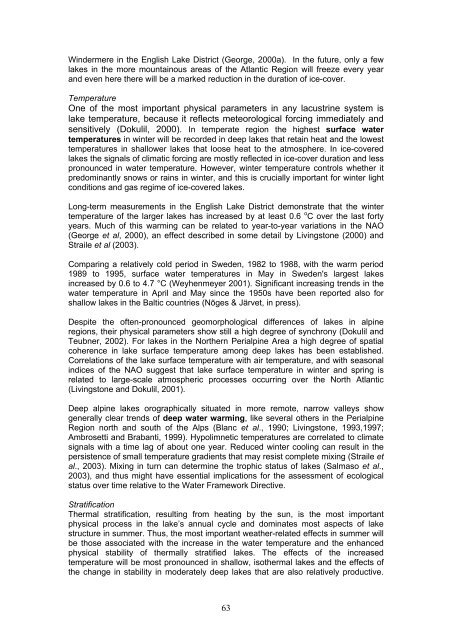Climate Change and the European Water Dimension - Agri ...
Climate Change and the European Water Dimension - Agri ...
Climate Change and the European Water Dimension - Agri ...
You also want an ePaper? Increase the reach of your titles
YUMPU automatically turns print PDFs into web optimized ePapers that Google loves.
Windermere in <strong>the</strong> English Lake District (George, 2000a). In <strong>the</strong> future, only a few<br />
lakes in <strong>the</strong> more mountainous areas of <strong>the</strong> Atlantic Region will freeze every year<br />
<strong>and</strong> even here <strong>the</strong>re will be a marked reduction in <strong>the</strong> duration of ice-cover.<br />
Temperature<br />
One of <strong>the</strong> most important physical parameters in any lacustrine system is<br />
lake temperature, because it reflects meteorological forcing immediately <strong>and</strong><br />
sensitively (Dokulil, 2000). In temperate region <strong>the</strong> highest surface water<br />
temperatures in winter will be recorded in deep lakes that retain heat <strong>and</strong> <strong>the</strong> lowest<br />
temperatures in shallower lakes that loose heat to <strong>the</strong> atmosphere. In ice-covered<br />
lakes <strong>the</strong> signals of climatic forcing are mostly reflected in ice-cover duration <strong>and</strong> less<br />
pronounced in water temperature. However, winter temperature controls whe<strong>the</strong>r it<br />
predominantly snows or rains in winter, <strong>and</strong> this is crucially important for winter light<br />
conditions <strong>and</strong> gas regime of ice-covered lakes.<br />
Long-term measurements in <strong>the</strong> English Lake District demonstrate that <strong>the</strong> winter<br />
temperature of <strong>the</strong> larger lakes has increased by at least 0.6 o C over <strong>the</strong> last forty<br />
years. Much of this warming can be related to year-to-year variations in <strong>the</strong> NAO<br />
(George et al, 2000), an effect described in some detail by Livingstone (2000) <strong>and</strong><br />
Straile et al (2003).<br />
Comparing a relatively cold period in Sweden, 1982 to 1988, with <strong>the</strong> warm period<br />
1989 to 1995, surface water temperatures in May in Sweden's largest lakes<br />
increased by 0.6 to 4.7 °C (Weyhenmeyer 2001). Significant increasing trends in <strong>the</strong><br />
water temperature in April <strong>and</strong> May since <strong>the</strong> 1950s have been reported also for<br />
shallow lakes in <strong>the</strong> Baltic countries (Nõges & Järvet, in press).<br />
Despite <strong>the</strong> often-pronounced geomorphological differences of lakes in alpine<br />
regions, <strong>the</strong>ir physical parameters show still a high degree of synchrony (Dokulil <strong>and</strong><br />
Teubner, 2002). For lakes in <strong>the</strong> Nor<strong>the</strong>rn Perialpine Area a high degree of spatial<br />
coherence in lake surface temperature among deep lakes has been established.<br />
Correlations of <strong>the</strong> lake surface temperature with air temperature, <strong>and</strong> with seasonal<br />
indices of <strong>the</strong> NAO suggest that lake surface temperature in winter <strong>and</strong> spring is<br />
related to large-scale atmospheric processes occurring over <strong>the</strong> North Atlantic<br />
(Livingstone <strong>and</strong> Dokulil, 2001).<br />
Deep alpine lakes orographically situated in more remote, narrow valleys show<br />
generally clear trends of deep water warming, like several o<strong>the</strong>rs in <strong>the</strong> Perialpine<br />
Region north <strong>and</strong> south of <strong>the</strong> Alps (Blanc et al., 1990; Livingstone, 1993,1997;<br />
Ambrosetti <strong>and</strong> Brabanti, 1999). Hypolimnetic temperatures are correlated to climate<br />
signals with a time lag of about one year. Reduced winter cooling can result in <strong>the</strong><br />
persistence of small temperature gradients that may resist complete mixing (Straile et<br />
al., 2003). Mixing in turn can determine <strong>the</strong> trophic status of lakes (Salmaso et al.,<br />
2003), <strong>and</strong> thus might have essential implications for <strong>the</strong> assessment of ecological<br />
status over time relative to <strong>the</strong> <strong>Water</strong> Framework Directive.<br />
Stratification<br />
Thermal stratification, resulting from heating by <strong>the</strong> sun, is <strong>the</strong> most important<br />
physical process in <strong>the</strong> lake’s annual cycle <strong>and</strong> dominates most aspects of lake<br />
structure in summer. Thus, <strong>the</strong> most important wea<strong>the</strong>r-related effects in summer will<br />
be those associated with <strong>the</strong> increase in <strong>the</strong> water temperature <strong>and</strong> <strong>the</strong> enhanced<br />
physical stability of <strong>the</strong>rmally stratified lakes. The effects of <strong>the</strong> increased<br />
temperature will be most pronounced in shallow, iso<strong>the</strong>rmal lakes <strong>and</strong> <strong>the</strong> effects of<br />
<strong>the</strong> change in stability in moderately deep lakes that are also relatively productive.<br />
63













